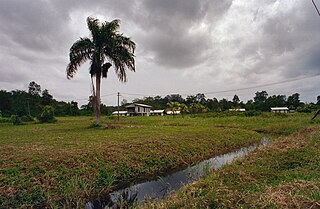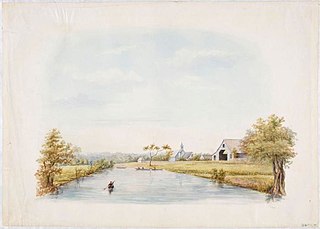
Commewijne is a district of Suriname, located on the right bank of the Suriname River. Commewijne's capital city is Nieuw Amsterdam. Tamanredjo is another major town, while Meerzorg is the most populated.

Berbice is a region along the Berbice River in Guyana, which was between 1627 and 1815 a colony of the Dutch Republic. After having been ceded to the United Kingdom of Great Britain and Ireland in the latter year, it was merged with Essequibo and Demerara to form the colony of British Guiana in 1831. In 1966, British Guiana gained independence as Guyana.

Wanhatti is a village and resort in Suriname, located in the Marowijne district on the Cottica River. The resort is inhabited by the Ndyuka Maroons, and has a population of 468 people as of 2012. The village is primarily inhabited by Ndyuka of the Ansu clan or lo.

Nieuw Amsterdam is the capital of the Commewijne District in Suriname. It is a small coastal town situated at the confluence of the Suriname River and Commewijne River, just across from Paramaribo, the country's capital. Its population at the 2012 census was 5,650, with around 1,200 people living in the main town, most of whom are of Javanese and East Indian origin. It is the location of the historical Fort Nieuw-Amsterdam, today an open-air museum. The town of Mariënburg with former sugarcane factory is located 3 km from Nieuw Amsterdam and part of the resort.

Commewijne River is a river in northern Suriname.

Tapanahoni is a resort in Suriname, located in the Sipaliwini District. Its population at the 2012 census was 13,808. Tapanahoni is a part of Sipaliwini which has no capital, but is directly governed from Paramaribo. Tapanahony is an enormous resort which encompasses a quarter of the country of Suriname. The most important town is Diitabiki which is the residence of the granman of the Ndyuka people since 1950, and the location of the oracle.

Joan or Johan van Scharphuysen, Scharphuizen or Jan van Scherpenhuizen was a Dutch colonist, a judge in Suriname, a slave-trader, colonial governor from 1689 to 1696 on behalf of the Society of Surinam, and a considerable plantation-owner.

The Society of Suriname was a Dutch private company, modelled on the ideas of Jean-Baptiste Colbert and set up on 21 May 1683 to profit from the management and defense of the Dutch Republic's colony of Suriname. It had three participants, with equal shares in the costs and benefits of the society; the city of Amsterdam, the family Van Aerssen van Sommelsdijck, and the Dutch West India Company. Only through mutual consent could these shareholders withdraw from the society.

Meerzorg is a town in Suriname, located on the eastern bank of the Suriname River, directly opposite the capital Paramaribo. Its population at the 2012 census was 12,405. Since 2000 it has been connected to Paramaribo by the Jules Wijdenbosch Bridge, named after the former President Jules Wijdenbosch.

Alkmaar is a resort in Suriname, located in the Commewijne District. Its population at the 2012 census was 5,561.
The Cassard expedition was a sea voyage by French Navy captain Jacques Cassard in 1712, during the War of the Spanish Succession. Targeting English, Dutch, and Portuguese possessions, he raided and ransomed the colonies of Cape Verde, Sint Eustatius, and Curaçao—factories, depots, and seasoning camps used in the Atlantic slave trade. He also raided and ransomed Montserrat, Antigua, Surinam, Berbice, and Essequibo—wealthy sugar-producing colonies in the Caribbean whose economies were based on the exploitation of slave labor.

Cornelis van Aerssen van Sommelsdijck was the first governor of Suriname after the establishment of the Society of Suriname in 1683. He was governor from 27 November 1683 until he was murdered by mutinous soldiers on 19 July 1688. Van Aerssen belonged to one of the richest families of the Dutch Golden Age.

Surinam was a Dutch plantation colony in the Guianas, neighboured by the equally Dutch colony of Berbice to the west, and the French colony of Cayenne to the east.
Cornelis van Aersens may refer to:

Fort Nieuw-Amsterdam is a fort in Suriname built from 1734 to 1747 at the confluence of the Suriname and Commewijne rivers. It is open to the public as an open-air museum.
Bokilifu Boni was a freedom fighter and guerrilla leader in Suriname, when it was under Dutch colonial rule. Born in Cottica to an enslaved African mother who escaped from her Dutch master, he grew up with her among the Maroons in the forest. He was such a powerful leader that his followers were known as Boni's people after him. They built a fort in the lowlands and conducted raids against Dutch plantations along the coast. Under pressure from Dutch regular army and hundreds of freedmen, they went east across the river into French Guiana. Boni continued to conduct raids from there, but was ultimately killed in warfare.

Braamspunt is a nature reserve, fishing village, and a former military outpost in the Johan & Margaretha resort of the Commewijne District of Suriname. Braamspunt is the most western point of the Commewijne District at the combined mouth of the Suriname and Commewijne River. The capital Paramaribo is located to the south of Braamspunt. The name is a corruption of Byam's Point which refers William Byam who was a quartermaster of Willoughby.

The Ferry terminal Leonsberg is a ferry jetty in the north of Paramaribo, Suriname. From here various private operators offer transport service the other side of the Suriname river and the Commewijne River.

Para Creek is a blackwater creek in the Wanica & Para District of Suriname. It is a tributary of the Suriname River, and was home to many plantations. The area around the creek has been cultivated since the English period. The Para District has been named after the creek in 1966.

















